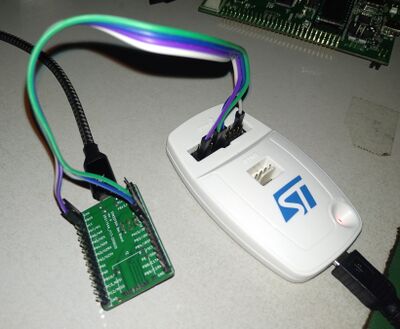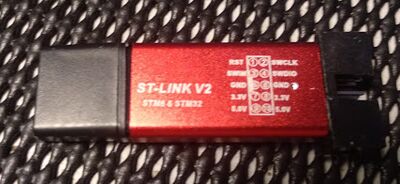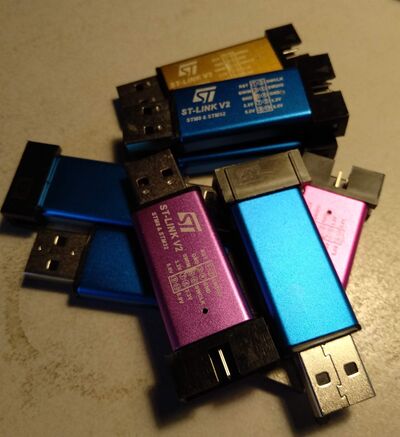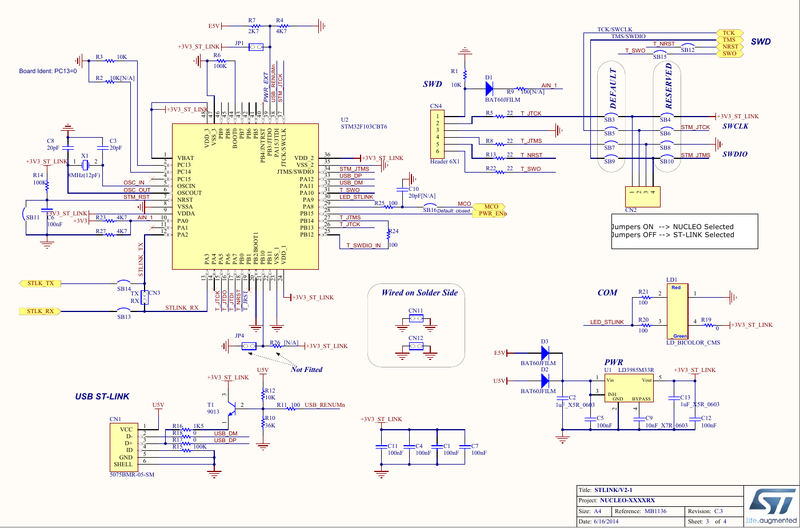Difference between revisions of "ST-Link"
| (17 intermediate revisions by the same user not shown) | |||
| Line 1: | Line 1: | ||
| − | [[Category:STM32]] [[Category:ST-Link]] | + | [[Category:STM32]][[Category:STM32 Hardware]][[Category:ST-Link]]{{metadesc|ST-Link STM32 Flash and Debugging tool}} |
| − | + | There's a number of different ways to flash [[STM32]] devices. One of these is to use [[ST]]'s own [[ST-Link]] devices using the [[Serial Wire Debug]] (aka [[SWD]]) protocol. | |
| − | There's a number of different ways to flash [[STM32]] devices. One of these is to use [[ST]]'s own [[ST-Link]] devices. | ||
[[File:STLink.jpg|400px]] | [[File:STLink.jpg|400px]] | ||
| Line 15: | Line 14: | ||
[[File:STLink-v2 (Chinese knock off).jpg|400px]] | [[File:STLink-v2 (Chinese knock off).jpg|400px]] | ||
| + | |||
| + | [[File:ST-Link Bunch.jpg|400px]] | ||
They are Chinese knock offs and they run the official [[ST-Link]] firmware. | They are Chinese knock offs and they run the official [[ST-Link]] firmware. | ||
| + | |||
| + | We are also running on a [[DIY ST-Link V2.1]] device. | ||
| + | |||
| + | == Hardware Analysis == | ||
| + | |||
| + | [[ST]] does not make schematics or source code available for the official ST-Link devices, which is a pity (and a someone odd business decision). However, they '''do''' publish a partial schematics since a built-in ST-Link device is included in all their development boards, a partial schematics is available. | ||
| + | |||
| + | [[File:ST-Link V2.png|800px]] | ||
| + | |||
| + | From the schematics we can see that the ST-Link device is build around a STM32F103CBT6 which is the 128 kB Flash version. | ||
| + | |||
| + | PC13 and PC14 (and possibly PC15 in the future) appears to be working as a means for the firmware to identify the "version" of the hardware. On above schematics, PC13 is pulled low with a resistor while PC14 (and PC15) are left floating. | ||
| + | |||
| + | A voltage divider splitting +3.3 V in half is connected to PA0 and labelled AIN_1. The ST-Link devices are capable of measuring the target processor supply voltage and this is probably a workaround of the development boards (which know their supply voltage already). | ||
| + | |||
| + | The "output" pins of the ST-Link V2 are as follows: | ||
| + | |||
| + | {| class="wikitable" | ||
| + | |- | ||
| + | ! Pin | ||
| + | ! Label | ||
| + | ! Remarks | ||
| + | |- | ||
| + | | PA0 | ||
| + | | AIN_1 | ||
| + | | Probably meant as an analog input, measuring the supply voltage on the target device. On the development boards, the supply voltage is well known, so this pin is connected to a voltage divider splitting the supply voltage in half (1.65V or thereabouts). | ||
| + | |- | ||
| + | | PA5 | ||
| + | | T_JTCK | ||
| + | | Target Clock | ||
| + | |- | ||
| + | | PA6 | ||
| + | | T_JTDO | ||
| + | | | ||
| + | |- | ||
| + | | PA7 | ||
| + | | T_JTDI | ||
| + | | | ||
| + | |- | ||
| + | | PA10 | ||
| + | | T_SWO | ||
| + | | Target trace debugging. This pin is unconnected on the Chinese clone ST-Links, which is annoying. | ||
| + | |- | ||
| + | | PA12 | ||
| + | | T_SWDIO_IN | ||
| + | | On development boards connected via a 100 Ohm resistor to PA14 | ||
| + | |- | ||
| + | | PA13 | ||
| + | | T_JTCK | ||
| + | | | ||
| + | |- | ||
| + | | PA14 | ||
| + | | T_JTMS | ||
| + | | | ||
| + | |- | ||
| + | | PB0 | ||
| + | | T_NRST | ||
| + | | | ||
| + | |- | ||
| + | | PB1 | ||
| + | | T_JRST | ||
| + | | Labelled but not connected to anything | ||
| + | |} | ||
| + | |||
| + | == More Reading == | ||
| + | |||
| + | Github user lujji have done a number of interesting writeups on ST-Link devices, reverse engineering the ST-Link firmware and adding trace (SWO) support to the cheap Chinese ST-Link devices. | ||
| + | |||
| + | * [https://lujji.github.io/blog/stlink-clone-trace/ Adding Trace support to ST-Link clones] | ||
| + | * [https://lujji.github.io/blog/reverse-engineering-stlink-firmware Reverse-engineering ST-Link firmware part 1] | ||
| + | * [https://lujji.github.io/blog/reverse-engineering-stlink-firmware-part2 Reverse-engineering ST-Link firmware part 2] | ||
Latest revision as of 01:08, 15 December 2022
There's a number of different ways to flash STM32 devices. One of these is to use ST's own ST-Link devices using the Serial Wire Debug (aka SWD) protocol.
There are multiple benefits of using one of these ST-Link devices rather than a plain serial dongle:
- The device need not be restarted in flash mode (Boot0)
- Programs can be debugged on the device
The official ST-Link as seen above are relatively cheap (< $20) and there are Chinese copies available (haven't tried those).
The most common option are these:
They are Chinese knock offs and they run the official ST-Link firmware.
We are also running on a DIY ST-Link V2.1 device.
Hardware Analysis
ST does not make schematics or source code available for the official ST-Link devices, which is a pity (and a someone odd business decision). However, they do publish a partial schematics since a built-in ST-Link device is included in all their development boards, a partial schematics is available.
From the schematics we can see that the ST-Link device is build around a STM32F103CBT6 which is the 128 kB Flash version.
PC13 and PC14 (and possibly PC15 in the future) appears to be working as a means for the firmware to identify the "version" of the hardware. On above schematics, PC13 is pulled low with a resistor while PC14 (and PC15) are left floating.
A voltage divider splitting +3.3 V in half is connected to PA0 and labelled AIN_1. The ST-Link devices are capable of measuring the target processor supply voltage and this is probably a workaround of the development boards (which know their supply voltage already).
The "output" pins of the ST-Link V2 are as follows:
| Pin | Label | Remarks |
|---|---|---|
| PA0 | AIN_1 | Probably meant as an analog input, measuring the supply voltage on the target device. On the development boards, the supply voltage is well known, so this pin is connected to a voltage divider splitting the supply voltage in half (1.65V or thereabouts). |
| PA5 | T_JTCK | Target Clock |
| PA6 | T_JTDO | |
| PA7 | T_JTDI | |
| PA10 | T_SWO | Target trace debugging. This pin is unconnected on the Chinese clone ST-Links, which is annoying. |
| PA12 | T_SWDIO_IN | On development boards connected via a 100 Ohm resistor to PA14 |
| PA13 | T_JTCK | |
| PA14 | T_JTMS | |
| PB0 | T_NRST | |
| PB1 | T_JRST | Labelled but not connected to anything |
More Reading
Github user lujji have done a number of interesting writeups on ST-Link devices, reverse engineering the ST-Link firmware and adding trace (SWO) support to the cheap Chinese ST-Link devices.



